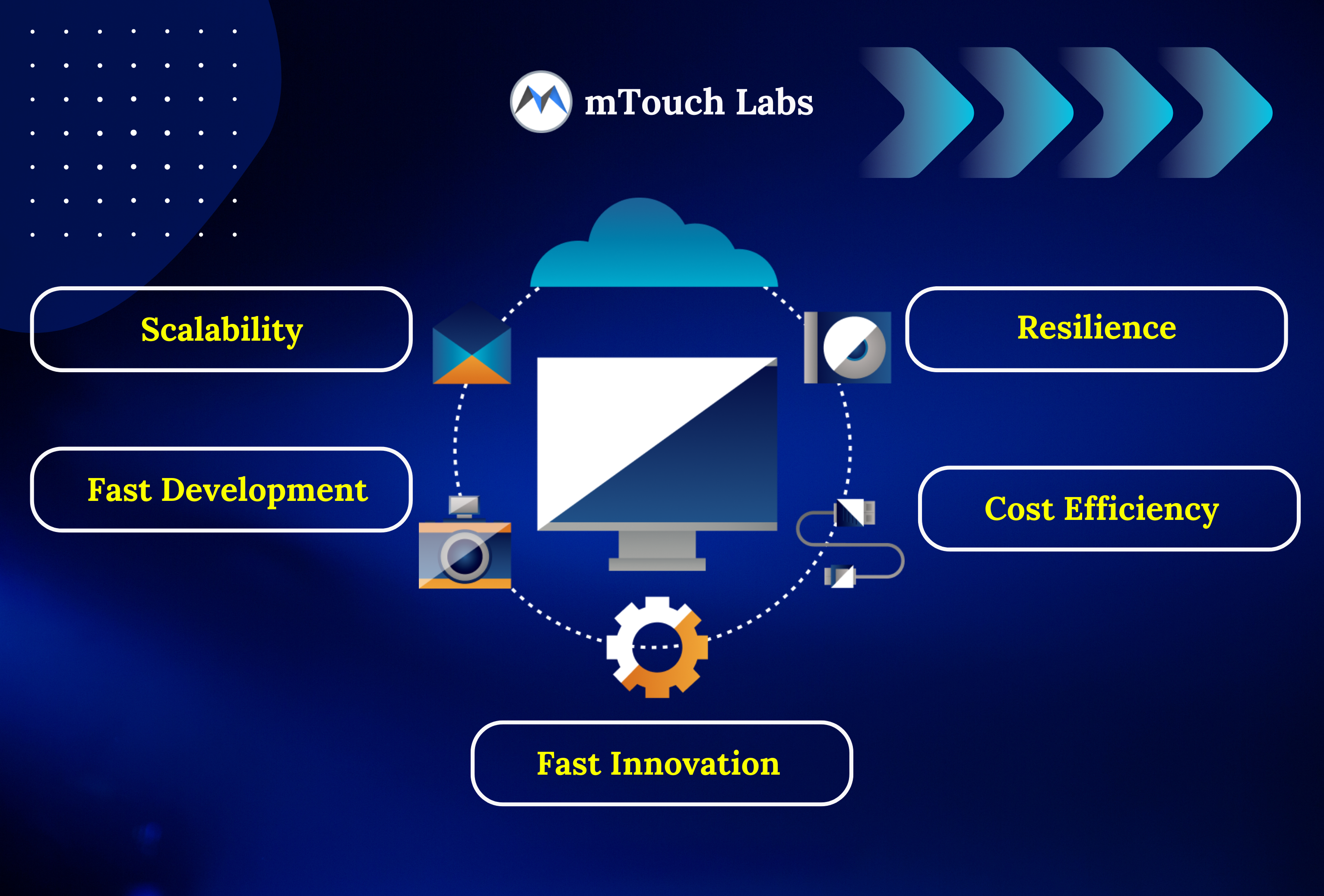contact@mtouchlabs.com
 +91 9390683154
+91 9390683154
 +1 (551) 222-0070
+1 (551) 222-0070

In the modern, fast-paced digital world, companies require an IT infrastructure that can adapt to changing needs. Businesses wishing to expand and develop can find a state-of-the-art answer in AWS services. Businesses may create scalable, resilient, and adaptable systems while expenses and increasing productivity by utilizing AWS Microservices. The smooth integration of several services made possible by these cloud-native solutions frees up companies to concentrate on what really counts expansion and innovation.
AWS offers the ideal platform for mobile app development companies to create secure, efficient, and high-performing apps. Through the integration of AWS services such as AWS Lambda, Amazon ECS, and AWS API Gateway, developers of mobile applications may guarantee their applications are extremely scalable while producing smooth user experiences. Businesses are able to provide reliable and responsive mobile applications that satisfy users' ever-rising demands as a consequence.
AWS-powered microservices, which divide big, monolithic systems into smaller, independent services that can scale and change on their own, provide a contemporary method of developing applications. With the help of Amazon ECS (Elastic Container Service), AWS Lambda, and AWS Fargate, among other powerful cloud-native tools, enterprises can easily deploy, manage, and scale microservices. AWS Microservices provide flexibility, resilience, and cost-effectiveness in contrast to traditional monolithic designs, which have closely connected components. This enables enterprises to swiftly adjust to changing demands while preserving excellent performance and reliability. Businesses may develop scalable, dynamic apps that fit well with the rapidly evolving digital landscape of today by utilizing AWS services.
AWS Microservices is transforming IT infrastructure by providing companies with cost-effective, scalable, and adaptable solutions. Rapid innovation and smooth application deployment are made possible by AWS's cloud-native capabilities.

Microservices on AWS provide unmatched scalability. Businesses may more efficiently deploy resources when each service can be scaled independently. For example, AWS can automatically scale a microservice with high demand without impacting other system components. This maintains cost effectiveness while guaranteeing improved performance during peak hours.
Faster development cycles are made possible via microservices. Without waiting for other application components to be finished, developers can work on particular components. Faster deployment and iteration result from this. Strong automation solutions from AWS, such as AWS CodePipeline and AWS CodeBuild, simplify the CI/CD (Continuous Integration/Continuous Delivery) pipeline and speed up and ease the deployment process.
AWS Microservices facilitate the development of robust applications. Because each microservice operates independently, the application as a whole is not affected when one fails. AWS ensures that your services continue to function even when issues occur in particular regions by offering tools like AWS CloudWatch for monitoring and AWS Auto Scaling for self-healing capabilities.
The cost-effectiveness of AWS Microservices is a design feature. Large servers that are unused are frequently required by traditional IT architecture, which results in needless expenses for enterprises. Businesses can scale services up or down in response to real-time demand using AWS Microservices, and they only pay for the computational power they utilize. The operational costs are greatly decreased by this pay-as-you-go concept.
Businesses can test new features and launch them fast thanks to AWS Microservices' flexibility and speed. Microservices' modular design frees companies from the limitations of monolithic architectures to innovate. Being the first to market can provide you a competitive edge in today's fast-paced market, therefore this is extremely important.
Amazon and other e-commerce giants use Amazon Web Services Microservices to handle millions of customer interactions and transactions. E-commerce platforms can manage inventory and authenticate customers in a highly scalable and resilient way thanks to microservices.
Systems that handle private patient information, offer real-time updates, and interface with different healthcare apps are created using AWS Microservices. The use of microservices by healthcare providers can provide improved security, performance, and adherence to industry rules.
Financial institutions may handle user accounts, conduct transactions, and scale their systems in response to market demands by utilizing AWS Microservices. Banks may provide their customers with services that are more responsive, secure, and flexible by putting microservices into practice.
Examine your current infrastructure before implementing AWS Microservices. Determine which domains, such as busy apps or intricate monolithic systems, could benefit the most from microservices.
Divide your monolithic application into more manageable, smaller services to transform it. Every microservice should concentrate on a particular business function and communicate with other microservices via clear APIs.
Use AWS technologies like Auto Scaling to modify resource allocation in response to traffic and performance demands and CloudWatch for real-time monitoring.
Optimization is a continuous effort while using AWS Microservices. Keep an eye on the performance of your application and adjust resources as necessary to satisfy changing business needs.
Microservices' scalability and flexibility are key components of the future of IT architecture. Businesses may lower operating expenses, increase agility, and speed up their digital transformation process with AWS Microservices. Whether you're managing banking systems, developing healthcare solutions, or growing an e-commerce platform, AWS Microservices can assist you in producing more inventive, resilient, and economical programs. Our specialty at mTouch Labs is using AWS Cloud Services to create innovative microservices designs that enable companies to stay one step ahead of their rivals. With mTouch Labs' experience leading the way, embrace the future of IT infrastructure with AWS Microservices and turn your company into a scalable, agile powerhouse equipped to handle tomorrow's challenges.